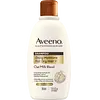What's inside
What's inside
 Key Ingredients
Key Ingredients

No key ingredients
 Benefits
Benefits

 Concerns
Concerns

 Ingredients Side-by-side
Ingredients Side-by-side

Colloidal Oatmeal Extract
HumectantWater
Skin ConditioningSodium C14-16 Olefin Sulfonate
CleansingCocamidopropyl Betaine
CleansingGlycol Distearate
EmollientSodium Chloride
MaskingHydrolyzed Milk Protein
Skin ConditioningPrunus Amygdalus Dulcis Seed Extract
Skin ConditioningPEG-7 Amodimethicone
HumectantPolyquaternium-22
Polyquaternium-39
Sodium Hydrolyzed Potato Starch Dodecenylsuccinate
Linoleamidopropyl Pg-Dimonium Chloride Phosphate
Laureth-4
EmulsifyingPEG-150 Pentaerythrityl Tetrastearate
EmulsifyingPPG-2 Hydroxyethyl Cocamide
EmulsifyingPropylene Glycol
HumectantGlycerin
HumectantAcrylates/C10-30 Alkyl Acrylate Crosspolymer
Emulsion StabilisingHexylene Glycol
EmulsifyingCitric Acid
BufferingSodium Citrate
BufferingSodium Hydroxide
BufferingSodium Benzoate
MaskingFormic Acid
PreservativeTocopheryl Acetate
AntioxidantLeuconostoc/Radish Root Ferment Filtrate
AntimicrobialCoconut Acid
CleansingDisodium Tetrapropenyl Succinate
Parfum
MaskingColloidal Oatmeal Extract, Water, Sodium C14-16 Olefin Sulfonate, Cocamidopropyl Betaine, Glycol Distearate, Sodium Chloride, Hydrolyzed Milk Protein, Prunus Amygdalus Dulcis Seed Extract, PEG-7 Amodimethicone, Polyquaternium-22, Polyquaternium-39, Sodium Hydrolyzed Potato Starch Dodecenylsuccinate, Linoleamidopropyl Pg-Dimonium Chloride Phosphate, Laureth-4, PEG-150 Pentaerythrityl Tetrastearate, PPG-2 Hydroxyethyl Cocamide, Propylene Glycol, Glycerin, Acrylates/C10-30 Alkyl Acrylate Crosspolymer, Hexylene Glycol, Citric Acid, Sodium Citrate, Sodium Hydroxide, Sodium Benzoate, Formic Acid, Tocopheryl Acetate, Leuconostoc/Radish Root Ferment Filtrate, Coconut Acid, Disodium Tetrapropenyl Succinate, Parfum
Water
Skin ConditioningVanilla Planifolia Fruit Extract
Skin ConditioningPropylene Glycol
HumectantCitrus Aurantium Dulcis Peel Cera
EmollientSodium Cetearyl Sulfate
CleansingFragaria Vesca Seed
AstringentParfum
MaskingCetearyl Alcohol
EmollientHoney
HumectantLanolin
EmollientSalvia Sclarea Oil
MaskingLavandula Angustifolia Oil
MaskingStyrax Benzoin Gum
MaskingCetrimonium Chloride
AntimicrobialPhenoxyethanol
PreservativeBenzyl Alcohol
PerfumingAlpha-Isomethyl Ionone
PerfumingCoumarin
PerfumingWater, Vanilla Planifolia Fruit Extract, Propylene Glycol, Citrus Aurantium Dulcis Peel Cera, Sodium Cetearyl Sulfate, Fragaria Vesca Seed, Parfum, Cetearyl Alcohol, Honey, Lanolin, Salvia Sclarea Oil, Lavandula Angustifolia Oil, Styrax Benzoin Gum, Cetrimonium Chloride, Phenoxyethanol, Benzyl Alcohol, Alpha-Isomethyl Ionone, Coumarin
 Reviews
Reviews

Ingredients Explained
These ingredients are found in both products.
Ingredients higher up in an ingredient list are typically present in a larger amount.
Parfum is a catch-all term for an ingredient or more that is used to give a scent to products.
Also called "fragrance", this ingredient can be a blend of hundreds of chemicals or plant oils. This means every product with "fragrance" or "parfum" in the ingredients list is a different mixture.
For instance, Habanolide is a proprietary trade name for a specific aroma chemical. When used as a fragrance ingredient in cosmetics, most aroma chemicals fall under the broad labeling category of “FRAGRANCE” or “PARFUM” according to EU and US regulations.
The term 'parfum' or 'fragrance' is not regulated in many countries. In many cases, it is up to the brand to define this term.
For instance, many brands choose to label themselves as "fragrance-free" because they are not using synthetic fragrances. However, their products may still contain ingredients such as essential oils that are considered a fragrance by INCI standards.
One example is Calendula flower extract. Calendula is an essential oil that still imparts a scent or 'fragrance'.
Depending on the blend, the ingredients in the mixture can cause allergies and sensitivities on the skin. Some ingredients that are known EU allergens include linalool and citronellol.
Parfum can also be used to mask or cover an unpleasant scent.
The bottom line is: not all fragrances/parfum/ingredients are created equally. If you are worried about fragrances, we recommend taking a closer look at an ingredient. And of course, we always recommend speaking with a professional.
Learn more about ParfumPropylene Glycol is an odorless, colorless liquid. As a humectant, it helps skin retain moisture. It also aids in delivering active ingredients.
Another role of this ingredient is preventing a product from melting or freezing. Propylene glycol also adds antimicrobrial properties to a product, elongating product lifespan.
This ingredient is considered an organic alcohol and commonly added into both cosmetics and foods.
Those with sensitive skin or conditions may develop a rash when using this ingredient.
Learn more about Propylene GlycolWater. It's the most common cosmetic ingredient of all. You'll usually see it at the top of ingredient lists, meaning that it makes up the largest part of the product.
So why is it so popular? Water most often acts as a solvent - this means that it helps dissolve other ingredients into the formulation.
You'll also recognize water as that liquid we all need to stay alive. If you see this, drink a glass of water. Stay hydrated!
Learn more about Water